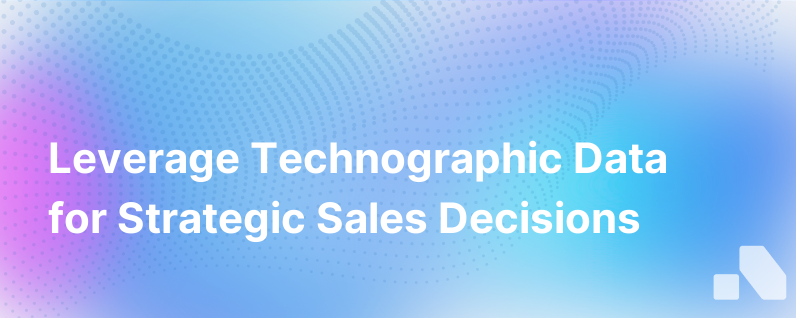
In the rapidly-evolving world of B2B sales and marketing, understanding the technological footprint of your potential customers—what software and hardware they currently use, how they're using it, and what they may need—is crucial. Technographic data, which encompasses this wealth of information, can be a goldmine for businesses looking to tailor their sales and marketing approaches, improve product development, or even refine customer support.
In this expansive exploration, we will delve into the world of technographic data, its significance, and the myriad ways in which businesses can harness this information to establish a competitive edge and drive growth. Whether you're a startup plotting to disrupt a niche market or an established enterprise seeking to reinforce your presence, mastering the use of technographic data can be transformative.
The Lifeblood of Modern Market Intelligence
Technographics represent the critical analytics of a company's technology stack—operations akin to demographics for individuals. By understanding which technologies a company implements, you gain a window into their corporate behavior, priorities, and potential needs. This information allows businesses to segment markets, personalize sales pitches, and develop more compelling marketing campaigns.
Core Applications of Technographic Data
Let's break down some of the most powerful uses of technographic data:
1. Enhanced Account Profiling and Lead Scoring
Technographic data expands the depth of company profiles, enriching the understanding of prospects and thereby allowing tailored interactions. By integrating technographic information into your lead scoring models, you can prioritize leads that use complementary or competitive technologies—signals that they might be ripe for conversion or upsell.
2. Precision-Targeted Marketing Campaigns
Knowing a prospect’s tech stack helps tailor content marketing and advertising strategies. For instance, if a prospect uses an e-commerce platform your product integrates with, campaigns can highlight this connection. Marketing teams can craft content that directly speaks to the benefits of integration, improving the relevance and efficiency of the campaign.
3. Competitive Analysis and Market Positioning
Technographic insights let you perform a deep dive into the competitive landscape by unveiling what solutions your potential customers are already using. This intelligence not only highlights potential competitive vulnerabilities but also identifies gaps in the market your offerings can fill, sharpening your market positioning strategies.
4. Product Development and Innovation
Product teams can leverage technographic data to drive the roadmap for development, ensuring compatibility with the technologies prevalent among the target audience. The insight gained can influence decisions around feature rollouts, integrations, and tech partnerships that deliver a competitive advantage.
5. Risk Assessment and Compliance
Performing a technographic analysis can reveal how potential clients manage risk and adhere to industry-specific compliance requirements. Solutions that help manage these concerns are particularly vital, offering a clear path to demonstrating value through your offerings.
6. Customized Sales Conversations
Armed with technographic data, sales teams can approach prospects intelligently, asking informed questions, and framing the conversation around existing technology ecosystems. This tailored approach leads to richer, more productive dialogues, and it positions your sales reps as advisors rather than vendors.
7. M&A Strategic Planning
For businesses considering mergers and acquisitions, technographic data can provide insights into the technological compatibility and synergies between companies, thereby informing due diligence and integration planning.
8. Churn Prediction and Prevention
Identifying technographic signals that precede churn, such as shifts in a client's tech stack, allows customer success managers to intervene proactively, extend client lifecycles, and potentially upsell auxiliary services that address emerging needs.
9. Identifying Up-Sell and Cross-Sell Opportunities
Understanding what complementary products a prospective customer is lacking, you can identify potential upsell or cross-sell opportunities, making offerings that make sense within their current technological setup.
10. Strategic Partnership Development
Technographic data can help identify potential partners who share common customer bases or have technologies that complement your own, facilitating collaborative initiatives and co-marketing agreements.
Case Study: Aomni in Action
Consider the example of Aomni, an AI-driven B2B sales platform. By leveraging technographic data, Aomni aids in recognizing customers’ existing tech stacks and provides actionable insights which help sales representatives tailor their messaging effectively. Not stopping there, Aomni continuously updates this information, offering sales and marketing teams a dynamic view of their prospects’ evolving technical environments in real-time.
In Summary
The use of technographic data is essential for companies looking to not only survive but thrive in the modern business landscape. This data forms the backbone of strategic decisions, enabling firms to move with precision and agility. From driving revenue growth through targeted marketing campaigns to empowering product development with actionable customer insights, the potential applications are vast and potent.
By integrating technographic insights into all facets of the organization—from sales and marketing to compliance and customer success—companies can ensure they remain attuned to their customer needs, stay ahead of market trends, and maintain robust competitive positioning.
In an age where every business decision can be data-driven, failing to leverage technographic data is no longer an option. It's time for companies to harness this intelligence and craft strategies that are as technology-savvy as the customers they seek to win over.